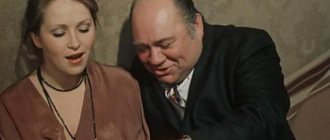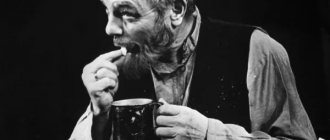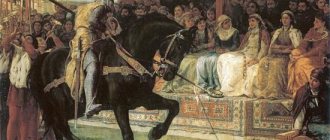Introduction to Plot and Characters
Before studying William Shakespeare's tragedy “Hamlet” in a summary, you need to familiarize yourself with the basis of the plot. Events take place in Elsinore, a royal residence located in Denmark.
Recently, sad news spread throughout the country - the king is dead. The throne is occupied by his brother, Claudius. Before his subjects, the future king makes two statements: about his imminent coronation and his marriage to the queen (the widow of his deceased brother). This news upsets Hamlet, the son of the deceased king. He is angry at how easily his mother and uncle forgot about their grief.
Before considering the plot, it is necessary to get acquainted with the characters of the play. The main characters of Hamlet:
- Hamlet is a prince, the son of a former king, and nephew of Claudius. Died at the hands of Laertes. Main character.
- Claudius is the king of Denmark. The killer of his brother, the former king. He took Gertrude as his wife and was killed by Hamlet.
- Polonius - holds the position of chief royal adviser, died at the hands of Hamlet. Has a daughter, Ophelia, and a son, Laertes.
- Laertes is the son of Polonius and brother of Ophelia. Engaged in fencing, killed by Hamlet. Also the one who killed Hamlet.
- Horatio is the prince's only true friend.
In addition to the main characters in the play, there are many secondary characters who influence the plot. These include:
- Ophelia - went crazy as a result of the death of her father, died by drowning in the river. She is the daughter of Polonius and sister of Laertes.
- Gertrude is the Queen of Denmark, married Claudius, and is the mother of the prince. After drinking wine that was poisoned by the king, she died.
- Ghost of the former king.
- Guildenstern, Rosencrantz - studied with the main character at the same university, were his comrades and died through his fault.
- Fortinbras is a prince from Norway.
- Marcellus, Bernardo - perform officer service.
Act Four
The fourth act of the tragedy is full of tragic events. Prince Hamlet seems to be going more and more crazy to those around him (a brief retelling of Act 4 will give a more accurate explanation of his actions).
Rosencrantz and Guildenstern ask Hamlet where Polonius' body is. The prince does not tell them, accusing the courtiers of only seeking the king's privileges and favor.
Ophelia is brought to the queen. The girl went crazy from the experience. Laertes returned secretly. He and a group of people supporting him defeated the guards and rushed to the castle.
Horatio is brought a letter from Hamlet, which says that the ship on which he sailed was captured by pirates. The prince is their prisoner.
The king tells Laertes, who is seeking revenge for the death of his father, who is to blame for his death, hoping that Laertes will kill Hamlet.
The Queen is brought the news that Ophelia has died. She drowned in the river.
Brief retelling of the work
A plot summary briefly describes the scenes and pays attention to all the acts. The story begins in the castle square. At midnight, Officer Bernardo takes over, replacing Guard Fernando. At this time Horatio and Marcellus come to the square. The second asks Bernardo about the ghost previously noticed by the guards. Horatio insists that this is a figment of the imagination.
Appearance of a ghost
The conversation is interrupted by a ghost who suddenly appears. His image is similar to the late king. After the ghost is asked who he is, he is insulted. He then abruptly disappears, with Horatio suggesting that this is a sign of upheaval threatening the country.
The situation made Marcellus think about the reasons for the country's active preparation for war. Horatio said that Hamlet killed the Norwegian prince Fortinbras during the battle. All the lands of the latter were placed at the disposal of the winner. Since then, the younger brother of the Norwegian prince vowed to recapture the lands. The interlocutors come to the conclusion that it was the cause of the unrest in the state.
After this, the otherworldly creature appears again just as unexpectedly, but it quickly disappears with the roosters crowing. Horatio is convinced that Hamlet should know about this story.
Claudius resents Fortinbras' plan to reclaim the lands, sending a letter to the King of Norway. In the letter, Claudius asks to stop any attempts to seize the territory. Laertes makes a request to the king, asking for permission to travel to France. To this Claudius gives a positive answer.
In a conversation with Hamlet, Gertrude asks her son to let go of grief about his father. She says: “What lives will die.” The Danish Prince is also told the news that he must stop his studies at Witenberg.
The scene ends with Hamlet talking to Horatio. The latter reports the ghost, promising to remain silent about this story.
The truth about the king's murder
Before his departure to France, Laertes tries to convince his sister to stop dating the Danish prince. He does not believe that Hamlet takes his beloved seriously. After her brother's departure, Ophelia told her father about Hamlet's courtship. Polonius strictly forbade any meetings with the prince.
Midnight came and Hamlet joined Marcellus and Horatio at the guard post. The ghost reappeared, ignoring attempts to ask him questions. Instead, he calls Hamlet to follow him.
The Ghost reveals his identity to Hamlet. This is his dead father and he wants the prince to take revenge on the killer. Everyone believes that the king died after being bitten by a snake. Claudius spread this lie to divert suspicion from himself. He poured a poisonous infusion of henbane into the king's ear. In addition, when Hamlet's father was alive, Claudius persuaded Gertrude to live together shamefully.
Returning, Hamlet warned his friends of his intentions to pretend to be mad. Horatio and Marcellus take an oath that everything that happens will remain a secret.
Hamlet's Madness
Ophelia disobeyed her father's ban and met Hamlet . The prince behaved strangely, causing concern. Ophelia tells Polonius that Hamlet has become mad. The royal advisor comes to the conclusion that the reason for his insanity lies in his love for his daughter.
Rosencrantz and Guildenstern are invited to a reception with the king and queen. They are asked to find out the reasons why the prince went mad. The friends' attempts were unsuccessful, as Hamlet realized that Claudius had sent them. In a conversation, the prince compares Denmark to a prison.
There will be a theatrical performance coming to Elsinore soon. The actors arrive and are greeted by the prince. He asks them to read Aeneas's monologue to Dido, illuminating the truth about the murder of Priam by Pyrrhus. The actors are also asked to include the play “The Murder of Gonzago” in the program. After its completion, a short passage written by the prince should be heard.
Theatrical performance and death of Polonius
Claudius finds out that madness does not lie in love for Ophelia. Fearing for his life, he sends Hamlet to England.
The actors are preparing for the performance. The prince asked Horatio to observe the king and his reaction during the performance.
While the play is being played out, Hamlet, in a conversation with Claudius, actively comments on what is happening. During the scene of the poisoning of the sleeping man, the king rises from his seat and leaves the hall.
Hamlet finds the king praying. He wants to atone for the poisoning of his brother. The prince decides to postpone the murder of Claudius so that his soul does not go to heaven.
The queen called the prince to her room, and Polonius hid behind the carpet. During a conversation with Hamlet, Gertrude hears furious accusations against her. She decided that her son was going to attack her. Because of this, Polonius begins to shout in order to attract the attention of the guards. The main character decides that Claudius is behind the carpet and stabs him with a sword.
Speaking towards the queen of the curse, the prince leaves. He drags the corpse of Polonius behind him.
Ophelia's madness, Laertes' revenge
The Danish prince was soon found and sent to England. Claudius decided it was time to do the British a favor by killing his nephew.
Ophelia becomes seriously depressed over the news of her father's death. Grief drives her to suicide. At this time, Laertes burst into the castle along with a large detachment of warriors. The rebels want Claudius dead and want to take the throne. But the king manages to pacify Laertes and conclude an alliance with him. The latter is furious over the death of his sister Ophelia and wants to take revenge on the prince at any cost.
Horace receives the letter written by Hamlet from the ship. It talks about the seizure of a ship by pirates. Hamlet asks the king to be notified about this so that he can urgently send troops to his aid.
Having learned about the imminent return of the main character, Laertes prepares for revenge. He decided to apply poison to the tip of his rapier to kill the prince.
The denouement of the last act
Ophelia's funeral. Shrouded in bitterness, Laertes throws himself into his grave. He screams that he wants to be buried with her. The prince does not believe him and is furious at the falseness of this act. He rushes after him and a fight ensues. The king orders them to be separated, and the prince challenges Ophelia's brother to a duel.
Horatio learns from the main character that he found the king's letter on the ship. In it, Claudius asks for the prince to be killed after his arrival in England. The prince changed the message. The new letter contains a request to kill the envoys of Denmark. They were Rosencrantz and Guildenstern.
Before the duel begins, the prince apologizes to Laertes and says that he did not mean harm. Claudius secretly pours poison into the protagonist's glass. In the heat of battle, Laertes pierces the prince with the tip of his rapier. The opponents exchanged rapiers, and Laertes also received a wound from his own weapon, on the tip of which poison was applied.
Gertrude accidentally drinks from the glass intended for the prince. She dies, and Laertes points out that it was Claudius who added the poison. The main character pierces Claudius with the tip of a poisoned rapier.
With his last words, Laertes forgave the prince. Horatio decides to drink the poison, but the prince manages to take the glass. He asks Horatio to inform everyone about the details of this story so that people know the truth.
Before his death, the Danish prince officially recognized Fortinbras' rights to the throne of the state. The latter gives the order that the prince must be buried with full honors. After this, loud sounds of cannon volleys rush by. This concludes the plot of Hamlet.
Brief summary of the acts
A condensed retelling introduced you to the development of the plot of the tragedy. If you would like to receive a more detailed and complete description of the events by chapter, or more precisely, by act and scene, in detail, we recommend reading the summary of William Shakespeare’s drama “Hamlet” given below.
Act I
In the first scene, the guard officers of the castle in the city of Elsinore observe the appearance of a ghost at night, similar in appearance to the late king. He died shortly after Hamlet won a battle with the Norwegian monarch Fortinbras. As a result of the fight, according to the agreement, Denmark received part of the lands of Norway. Horatio witnesses the ghost's appearance and realizes that the state will have to go through serious upheavals. The guards turn to the spirit of Hamlet's father, asking why he comes. But the ghost does not answer and disappears after the rooster crows.
The guards and Horatio noticed the ghost
In the second scene, Claudius, who took the throne after the death of his brother, announces his intention to take as his wife the widowed queen, “the heiress of the military frontiers.” He sends a letter with Voltimand and Cornelius to the King of Norway with a request to stop his nephew’s plans to reconquer the lost lands. As an argument, he points out that the army assembled by the younger Fortinbras “for the bread of thugs ready for battle” is maintained at the expense of the state treasury.
The son of the chief royal adviser, Laertes, after the coronation of Claudius, receives permission from the monarch to return to France. The king and his wife talk with Hamlet, comforting him in his grief over the loss of his father. Claudius convinces the young man that excessively indulging in sadness is “a sin against heaven, a sin against the dead,” one should submit to fate and take the turns of fate for granted. The ruling couple asks the prince not to return to Wittenberg for the time being to continue his studies.
Left alone, Hamlet dreams of leaving this world, where everything seems insignificant to him. He suffers, reflecting on the fact that his mother almost immediately after the death of her husband, who loved her dearly, remarried. Excited Horatio tells Hamlet about the appearance of the ghost of the dead king. The prince asks his friend and the guards not to tell anyone about what they saw.
In the third scene, Laertes asks his sister Ophelia not to trust Hamlet's declarations of love, since he is a hostage to his origin and has no right to give in to his heart. The heir to the throne is obliged to restrain his heartfelt impulses and choose a spouse taking into account state benefits. Having received his father's instructions, Laertes sets off. Polonius talks to his daughter, also advising her not to believe Hamlet’s oaths, assuring that these are short flashes of desire, and not real love.
Act II
In the first scene, Polonius instructs Reynaldo to find out in Paris about Laertes' behavior. Ophelia tells her father about a strange meeting with Hamlet. He was very excited, dressed sloppily, squeezed her hand in his hand, then bowed three times and left the room. Next, the king instructs Hamlet’s peers, who have known the prince since school, to find out the reason for the change in the prince, and whether he is keeping any secrets. But they fail to find out anything new: the prince is very careful and prudent.
Polonius talks with envoys who arrived with a response from the ruler of Norway. He thanks for the information about the upcoming battles and assures that he has taken measures to stop them. The Norwegian monarch allowed his nephew to go with his army on a campaign against Poland. The ambassadors conveyed to the king a written request to let the soldiers pass through the territory of Denmark with a guarantee that they would not harm the Danes.
Characteristics of images
All events from the first to the last chapter last several days. Despite this, the work is distinguished by its deep elaboration of the characters. The main difference between the characters is their ability to see a ghost. Only people with a pure heart and soul could do this. All images are divided into three categories, taking into account the ideological significance in the description of events:
- The author included Hamlet, Claudius and Gertrude as the main characters of the story;
- persons influencing what is happening include the ghost of the former king, Polonius, Ophelia, Laertes, Horatio, Rosencrantz, Guildenstern, Fortinbras;
- Secondary persons include sailors, captain, gravediggers, watchmen, nobles and others.
Hamlet's characterization is controversial. The uniqueness of the image lies in the gradual development and change of values. In the first and last acts the image is radically different. The character is gradually led from thoughts to action by a split consciousness, an analysis of his own strengths and capabilities, a desire to live conscientiously, as well as a large number of doubts and reproaches addressed to himself. The Danish prince has contradictory qualities:
- courtesy and rudeness;
- hatred and love;
- fear of God's punishment and blasphemy.
Contradictions develop from the first to the last letter of the work. By the standards of philosophical and humanistic teachings, the main character reflects universal human values. The play shows how justice, honor and morality are hardened and sometimes decomposed.
As the abridged text shows, the Danish prince is a personality of a new generation, whose strengths and weaknesses are expressed by mental acuity and morality. Although the character is a humanist and philosopher by nature, circumstances force him to desire revenge and bloodshed.
This is the main element of Hamlet's tragedy. A pure-hearted person faces betrayal and fratricide, becoming disillusioned with people and his own beliefs. Against this backdrop, the old foundations are crumbling, and others, less moral ones, are taking their place.
William Shakespeare asks the main question: “To be or not to be?” It reflects, first of all, how a person can change under the influence of irreparable circumstances. The answer to this question falls on the shoulders of the reader. To plunge even deeper into the experiences of the characters, after a brief retelling, it is recommended to read the play in its entirety. This is the only way to draw full conclusions regarding the actions of the main character.









